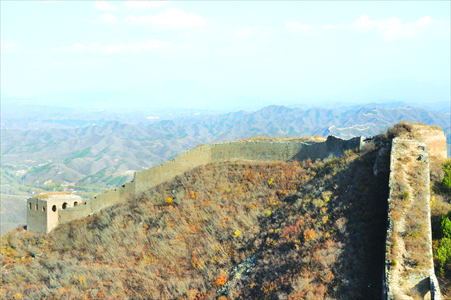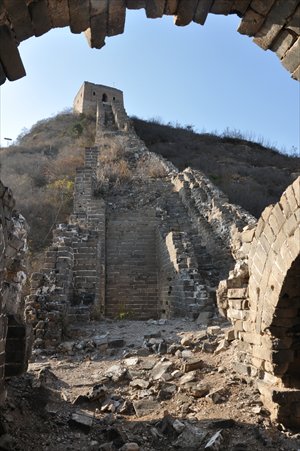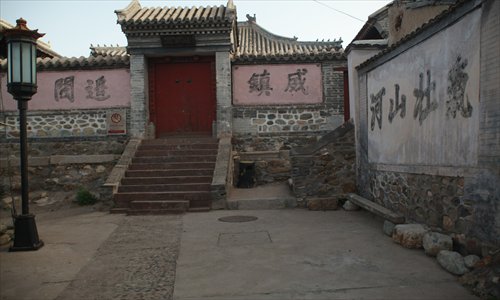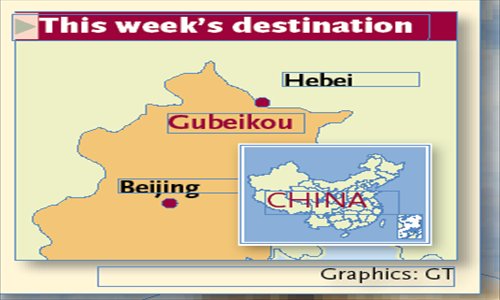Call of the wild




"One cannot be called a real man until he has reached the Great Wall." This is a famous line from one of Mao Zedong's poems. But if you visit the Badaling section of the Great Wall, the best-known among tourists, especially during a big Chinese holiday, you may find yourself in an awkward situation: The scenery is good, but it's hard to enjoy it when you are squeezed in a big crowd.
To avoid the throngs of tourists, many are choosing to explore other parts of the more than 8,000-kilometer-long Great Wall, mostly built during the Ming Dynasty (1368-1644), or its remains in some cases, as many segments have not been repaired in decades or even centuries.
There are a great number of wild sections of the Great Wall outside of urban Beijing and in the nearby Hebei Province. I chose to see a place called Gubeikou, as it is not too far and is ideal for a day trip or weekend excursion. It is also worth visiting for the cluster of attractions that surround this stretch of wild wall.
Hidden history of Gubeikou
Located in northeastern Miyun county, Gubeikou is about 120 kilometers from downtown Beijing. As small as it is, a total of about 25 kilometers of the Great Wall snakes through the town. It consists of four main parts: Wohushan Great Wall, Panlongshan Great Wall, Simatai Great Wall and Jinshanling Great Wall, which is mostly in Hebei Province.
Built during the later years of the Northern and Southern Dynasties (386-589), and reinforced during the reign of Emperor Hongwu (1368-98) of the Ming Dynasty, this part of the Great Wall has a history of over 1,000 years.
Like the other parts of the Great Wall, its original purpose was to ward off invaders from the northern areas. And as a strategic pass to Inner Mongolia and Northeast China, over the centuries, it has witnessed countless wars, 138 of which were recorded in historical documents.
This area of the wall began to fall into disrepair during the early Qing Dynasty (1644-1911), as Emperor Kangxi (1654-1722) believed even the strongest wall could not prevent war if the ruler did not have the support of civilians.
However, battles on the Gubeikou Great Wall were a common occurrence after his rule, the most recent skirmish being in 1933, when three Chinese divisions fought against an invasion from the Japanese army. The clash lasted for over two months, from March to May, with casualties of more than 4,000 on the Chinese side and 2,000 on the Japanese side.
This incident is remembered as a bloody chapter in Chinese history, with a mass grave of over 360 Chinese soldiers buried at the foot of this section of the Great Wall.
Each of the four parts of the Gubeikou Great Wall is known for something different.
Jinshanling is famous for the large number of different buildings that were constructed along the wall, varying in structure and form. Simatai is known for its danger, as much of this section was built on high bluffs, and some areas are so steep they're nearly upright.
The Panlongshan section, named for Panlong Hill, which lies at a relatively low 150 meters at its highest point, has the most storied past. It is said that Qi Jiguang, an important Ming Dynasty general, used one of the buildings as an office, and the top of another building was blown off by a Japanese plane in 1933.
The Wohushan section is on Wohu Hill, from whose summit hikers can view the nearby village and some of the best scenery the Great Wall has to offer.
The climb up
For those who are not interested in the history or structure of the Great Wall, or those with limited time, one or two sections of the four might be preferable.
As a visitor who did not have much knowledge about local geography, I was led by GPS to the foot of Wohu Hill before I realized it. Yet, it was not easy to find the right way up, though the Great Wall seemed just within reach.
As it is an informal tourist site, there are no signs or arrows to help visitors find their way. If it were not for the guidance of a local woman, I might have spent the rest of the day wandering at the foot of the hill, because the path openings were so heavily covered in branches.
The lower end of the path was made of dirt and stone, flat and wide, lined with thickets of wild trees I could not name. In the late autumn season, the folds of yellow, red and brown leaves reminded me of Fragrant Hills Park (Beijing's biggest destination for viewing autumn leaves). But in fact, being on the wall was more rewarding, as Fragrant Hills is notoriously overcrowded and its leaves are often picked away.
About 15 minutes into my trek, the path gradually became narrow and steep. Very often, there was only room enough for one person to pass at a time, with nothing to hold on to for safety.
Climbers also need to look out for loose stones underfoot, as they can easily cause you to lose your footing, as well as sharp spines of the nearby plants, which may hurt you or snag your clothes.
Yet, despite all these cautionary warnings, for those who seek a raw adventure, this journey is right up your alley. The walk up to the wall takes over 30 minutes, and it's a hard climb for some. Once the top is reached, the pace can be slowed and the scenery simply enjoyed.
Endangered future
I had a conflicted feeling when I finally stood on the remains of the Great Wall. On one hand I admired such a great feat of construction, completely made by hand hundreds of years ago, but on the other hand, I felt regret for how it looked now.
Parts of the wall have collapsed, with few complete bricks still in place. Grasses grow in abundance through the cracks between bricks, which also bear the scars of past battles, acting as a constant reminder of the bloody history of this monument.
Between crumbling segments, there are also parts of the wall that are in relatively good condition, but from time to time, you will find the names of previous visitors carved into the many-storied bricks.
You will also find that some bricks are missing, leaving a dreadful hole in the wall.
Beside the Great Wall, in the bushes, there is often litter, like empty bottles, plastic bags, used tissues and empty cigarette packs.
One of my traveling companions, surnamed Zhao, who had been to many other parts of the Great Wall, told me that littering is common in many other areas as well. And what's worse, some local residents steal bricks from the Great Wall to sell.
"The damage to the Great Wall comes not only from nature, but also from people," as Duan Qingbo, vice president of the School of Cultural Heritage at Northwest University in Xian, told the Global Times, adding that even some local governments have brought damage to the Great Wall while constructing railroads or highways. "They think this part of the Great Wall has already collapsed and hardly resembles its earlier self."
Duan said that in 2006, the State Council announced a regulation to protect the Great Wall, and there are similar written articles in the Cultural Relics Protection Law, but the enforcement of these regulations and rules has been weak.
"[Awareness] not only among citizens but also among management authorities is needed," Duan added.
Additional sites
Gubeikou's attractions include more than its sections of the Great Wall, such as the three-bore well, the ancient royal road, the Yang Linggong memorial temple, and Yaowang (a medicinal king and bodhisattva) temple.
Though much less grand than the historical sites in Beijing, each is linked to old folk legends, which add an element of mystery.
The three-bore well, for example, is said to provide three different flavors of water, each bore offering a distinct taste.
It is said that He Sheng, a corrupt Qing Dynasty official, wanted to fawn on Emperor Qianlong (1711-99) and said he could taste three different flavors from the well. But his petty trick was sidelined by two other loyal officials, who suggested that the emperor give He the honor of representing him and distributing the tri-flavored well water to all members of the entourage. As a result, He had to stay up all night distributing water.
Yang Linggong temple was built in honor of a Song Dynasty general named Yang Linggong and his family. Yang and his family are famous for their bravery in fighting against the invasion of Liao, an ancient northern tribe. Legend has it that the temple was built by his enemies, for even they admired his bravery.
The temple has two halls, each of which has a series of outer rooms, together totaling over 20 rooms. Most of the buildings of the temple were built with earth and wood, and the complex occupies about 1,200 square meters.
Finally, there is an unassuming road east of the temple. Small as it is, it used to be a road for the royal family.
This road was built during the Emperor Kangxi period, and was one of most used roads of the era. Whether the emperor wanted to go hunting in the forest, patrol the borders, or go to his summer dwelling palace when it grew too hot, this is the way they had to pass.
With the vistas up high and the sites down on the ground, Gubeikou has something for everyone.
Rules of Thumb
There are many ways tourists can get to Gubeikou from downtown Beijing, either by car, bus or train. Trains are recommended as the bus can take up to six hours. You can take train No.4471, which leaves from Beijing North Railway Station. Though there is no ticket available for Gubeikou, you can buy one to Huairou North and then get off at the Gubeikou stop.
Another option is the No.980 bus from Dongzhimen long-distance bus station, which will take you to Miyun county. Get off at Miyun Station, and then transfer to the No.25 bus to Gubeikou Station. From there, you will have a kilometer walk to the foot of the hill that the Great Wall was built on.
For those who prefer to drive, just follow the G110 road to its end. It takes about two hours.
Accommodations can be found very close to the wall, if you want to stay in local people's houses. It's about 40 yuan($6.41)/person/night in folk houses, and about 80 yuan for three meals each day.